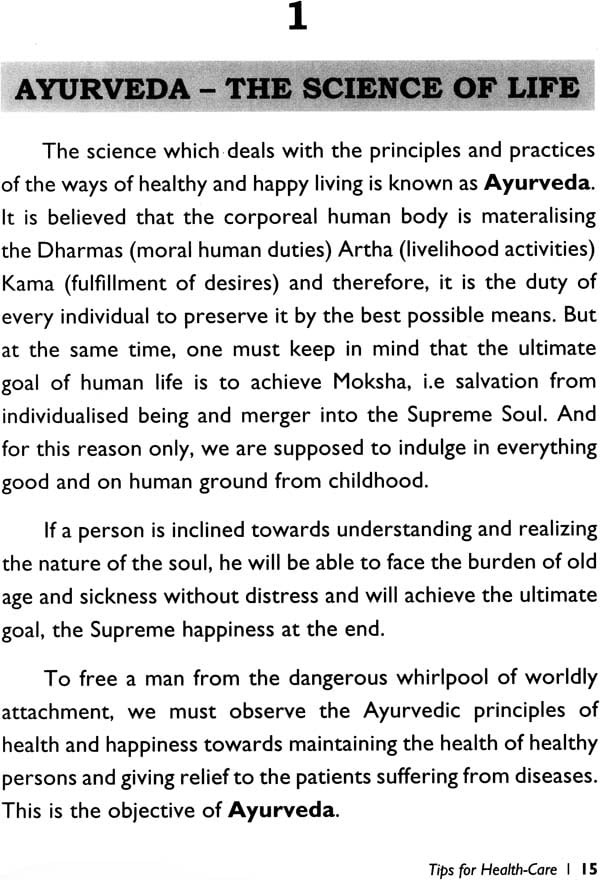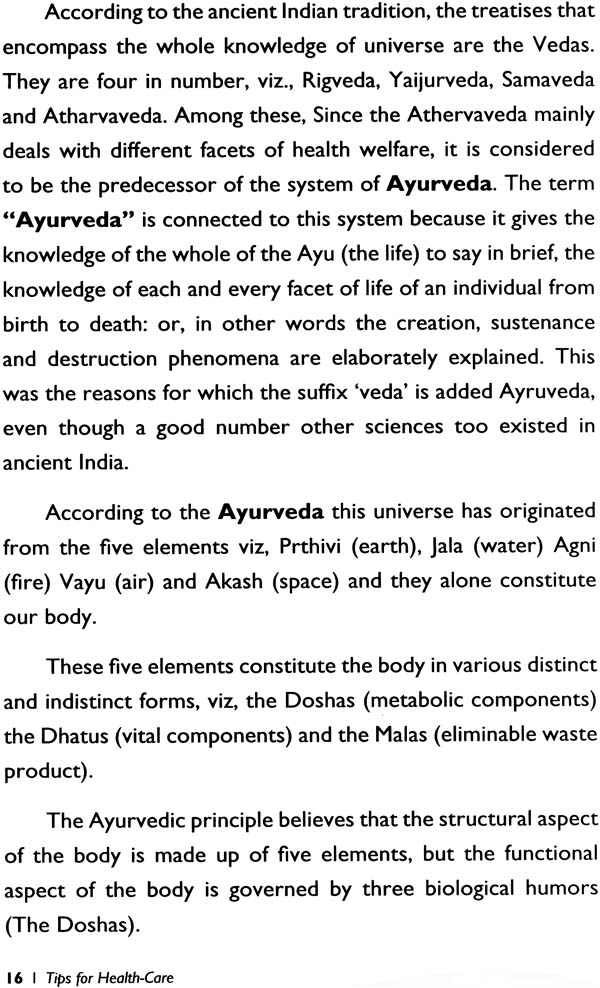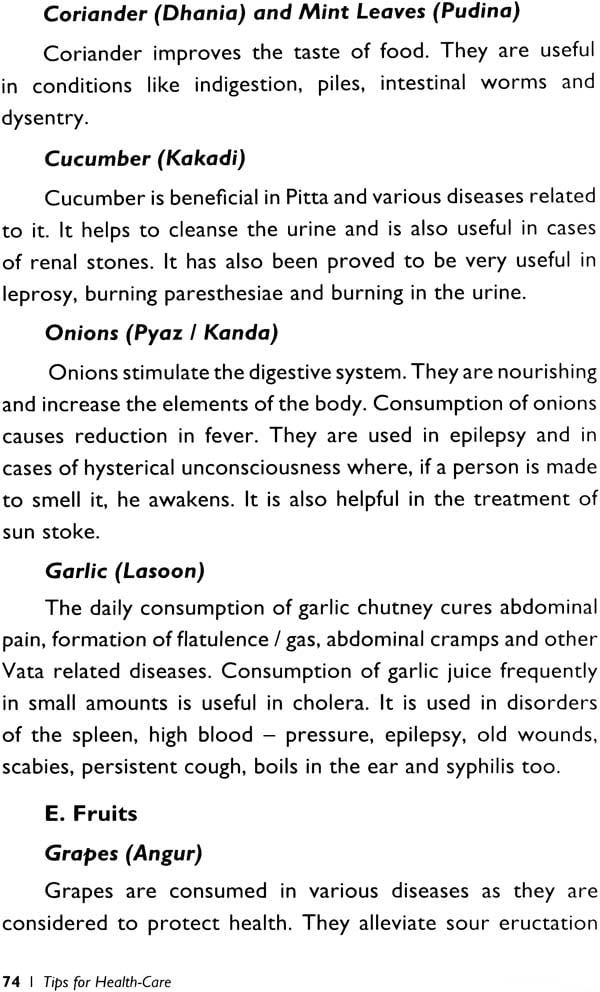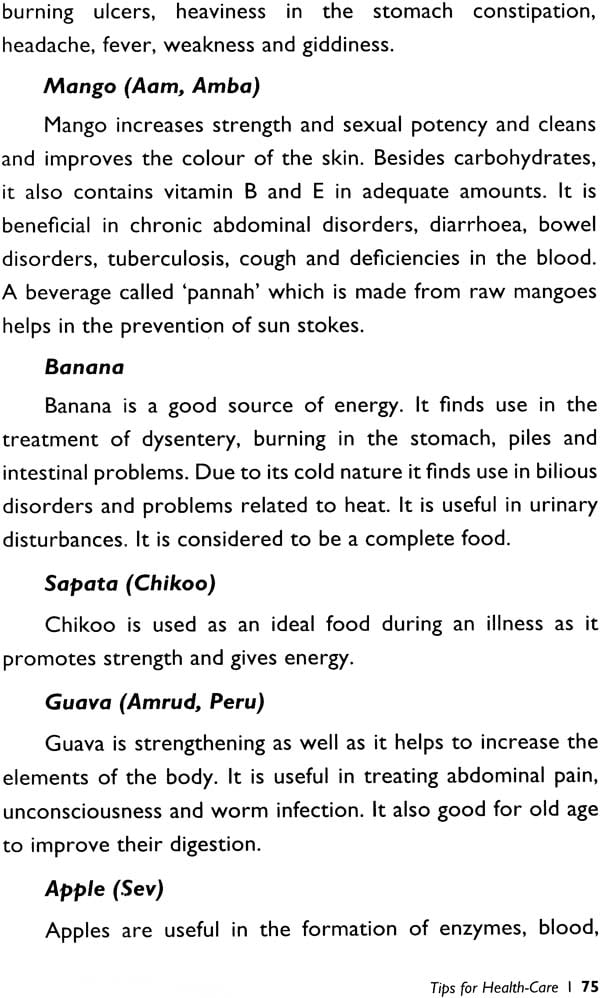
Tips for Health Care
Book Specification
| Item Code: | NAI490 |
| Author: | Vaidya Suresh Chaturvedi |
| Publisher: | Bharatiya Vidya Bhavan |
| Language: | English |
| Edition: | 2014 |
| ISBN: | 9788172765057 |
| Pages: | 96 |
| Cover: | Paperback |
| Other Details | 8.5 inch X 5.5 inch |
| Weight | 160 gm |
Book Description
Natural wholesomeness of the body, mind and Spirit is called health. The contact of life with unpleasantness is called disease. Health is viewed as not merely the absence of disease but a state of complete physical, mental and social well-being.
Good health depends on regulated ways of living in a healthy environment, eating nutritious food properly, using safe drinking water and improved sanitation, practice of yoga and physical exercises, avoidance of harmful behaviours besides appropriate preventive and curative health care. A well maintained body is the fundamental objective of living in order to pursue the well known four objectives of human life ie. Dharma-duties, artha-proper usage of organs, Kaama-to gratify desires of personal nature even sexual needs, and the moksha-salvation.
About one quarter of world's annual maternal deaths occur in India and 19% of the total under five child mortality. Cancer kills 50 people in India every hour, while 7 per cent of country's adult population is estimated to be suffering from mental health problems. Poverty and poor health reinforce each other everywhere. To resolve these problems let us adopt a healthy way of living for enjoying all the physical and mental pleasures and ensuring health for all.
Live long! This benediction is the blessed motto of Ayuraved. Vaidya Suresh Chaturvedi is a world authority on Ayurved and has written many books to his credit and convinced million of people to adopt Ayurvedic principles for attaining health, happiness and long life. For attaining good health inventions on multiple fronts are required, which include:-
• Community sensitization on, water, sanitation, hygiene, environment and nutrition for good health;
• Behaviour change campaigns for leaving consumption of Tobacco, alcohol, drugs and excess use of salt in processed foods;
• Compaigns on mental illness; and
• No one should be doomed to a short life because he or she happens to be ethnic group or race or the 'Wrong' sex.
This book 'Tips for Health Care' is a short and careful review of philosophy, discipline and contents of an Ayurvedic practice. It describes the Yoga and Samkhya beliefs and stresses on people to adopt good behaviour choices for healthy living. Simple tips on health care described in the book can easily be adopted by all without incurring any additional expenditure.
I hope the book will help the people to rediscover the joy of living and make the world healthy, wealthy and worth living.
Ayurveda is one of the oldest sciences of human well being stemming from more than 5000 years old Vedic writings and it primarily addresses the issues of freedom from sickness, maintenance of a happy and healthy life, and nurturing a graceful old age which should lead to state of keeping a body fit, alertness in mind, a kind of liveliness and the individual soul in delight.
Keeping in line with the hymnal writings the Ayurvedic ideas were also conveyed through very well spelled out maxims. To decode these maxims is not an easy task especially for the common man because they are pregnant with deeper and relatively a newer outlook on life especially in the times of a general disconnect with the total picture of life. During the course of his practice as an Ayurvedic physician, he became aware of many misgivings and lack of knowledge on the part of general public about Ayurveda. He looked for ways and tried his best to draw the attention of people to simpler ways of handling health problems, but he felt it required a jotting down of ideas with directness in fewer words for general public. He followed a simpler layout from the objectives of human life to the definition of human body, the apparent nature of health, the causes of a diseased condition, the effective cures, the restoration of health in body, and the context of moral structure of human life.
Instead of voluminous desiderata he decided to offer tips which are easy to remember and review in the course of general day-to-day living. He did give hints about various holy books and the material covered there in, but he did not want the public distracted so kept to the main issues of day-to-day living in the context of theory of three metabolic components or humours - vaata, pitta and kapha, the seven vital components i.e.,dhatus, three or four basic elements of living - regularity, diet, brahmacharya and sleep, and a balanced outlook on vegas. He wanted people to realize the basic fact that it was imperative to be aware of our own mental makeup. As a practitioner and a householder he was able to grasp a general atmosphere of sickness in the community and a general desperation and a climate of quick-fix approach to sickness. Modern life style has made life into a peg to fit into the scheme of industrial revolution and the time table that inbreeds a departure from regularity of human body functions, and it has also produced all kinds of unchecked diet patterns, the lack of healthy restrain upon sexual urges, and a reckless sleep disorder.
I hope his attempt proves helpful to those who are looking for genuine answers and want to reclaim a healthy life.
Human beings want to live, and on top of it want to live long and they have been struggling with the idea of diseased conditions of the body, with its causes, and their attempts to free themselves of the sickness. They know very well that if a diseased condition remains untreated then it may cause harm to life. It is in this sense that the health and the life work hand in hand. Few shall look for the causes outside of their bodies, and perhaps it is partially true. But the Ayurvedic (a science promising a long life) system has been reminding people that causes for their indisposition should be looked inside, meaning thereby that the food, self-abuse, unregulated life, and stretching the human limits could very well be the most immediate causes for their sickness and all these could be easily avoided by personal self-discipline. The Ayurvedic system of medicine goes back to thousands of years and in as much being a body of knowledge spelled out by pioneer exponents like Charaka, Sushruta, and Vagbhatta and later scholars such as Nagarjuna Sharngdhara, Madhava and others, it was actually very much a part of everyday life of general public of India. I have been a Vaidya but at the same time I also observed what my wife, Sudha, cooked and how she kept us well and it went to prove that Indian eating habits had incorporated Ayurvedic instructions since time immemorial. Years ago, in the year 1944, when I went to study at Lahore, I decided that I shall try to remind community in the course of my practice and as well as through my writings that After a long effort, now it is in the hand of the readers very simple tips could free human beings from many sicknesses and they did not have to live in fear of and be dependent upon non-organic medicines.
I wrote several books on various subjects but I was being pressed by many of my patients that there was a need of a more direct and simpler exposition of these health care tips.
I looked into the body of my knowledge and experience and decided to bring this knowledge to the people in a very simple and progressive discussion. I divided the present work in chapters telling us the objectives of human life, the nature and components of human body, the definition of a healthy body, the articles and efforts towards maintaining general well being, the reasons for the incidence of diseases, and in what way those causes could be addressed towards restoring the health and how human health was very much an important part of Human Life. I also tried to put this information by way of small tips towards health-care so that people were not discouraged by the volume of information. I had been working on this project for many years and had published some of it in the form of a book called 'Aarogya sumana', in Hindi. After some years my friend Dr. S. K. Pidara repeatedly suggested that a fuller version would be a welcome thing and he could help me in this endeavour.
After a long effort, now it is in the hand of the readers.
| 1 | Ayurveda - The Science of life | 15 |
| 2 | Human life and its objectives | 23 |
| 3 | Human body organs | 27 |
| 4 | Human Health | 29 |
| 5 | Human Health Promotion | 32 |
| 6 | Causes of Diseases | 43 |
| 7 | Restoration of Health | 49 |
| 8 | Good conduct and Health | 53 |
| 9 | Yoga and Health | 59 |
| 10 | Diet and Health | 64 |
| 11 | Home Remedies and Beauty Remedies | 83 |









